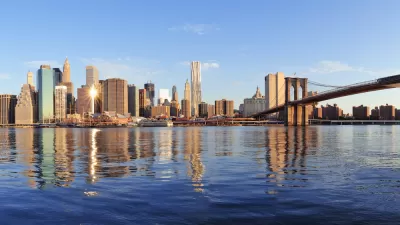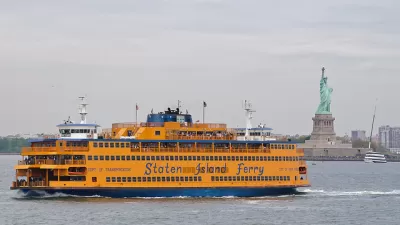About 80 percent of New York City's greenhouse gas emissions come from its building stock, so the city's goal to cut emissions 80 percent by 2050 will hinge on aggressive retrofitting requirements in addition to new green building standards.
David Giambusso and Brendan Cheney explore the status of OneNYC—the city of New York's plan to reduce greenhouse gas emissions 80 percent by 2050. OneNYC, championed by Mayor Bill de Blasio, includes one particularly challenging component: cutting emissions from buildings 80 percent by 2050.
The article discusses the work that's been accomplished toward realizing a path to that target:
Since introducing the 'One City: Built to Last' policy paper in September 2014, a working group of energy, real estate and environmental experts has been meeting to come up with a series of recommendations on how to reduce building emissions. Despite de Blasio’s threat to mandate energy retrofits, it does not appear that will happen any time soon.
According to Giambusso and Cheney's sources, the city "will have to make more dramatic changes to its existing building stock to make it more energy efficient" by 2025 if it wishes to reach its target. Included among the possibilities would be "Passive House" requirements for new construction. A much larger challenges, according to the case presented in the article, would be covering the cost of retrofitting existing buildings.
The article includes more discussion about the de Blasio Administration's progress on the other components of OneNYC.
FULL STORY: De Blasio’s green agenda making slow but steady progress

Alabama: Trump Terminates Settlements for Black Communities Harmed By Raw Sewage
Trump deemed the landmark civil rights agreement “illegal DEI and environmental justice policy.”

Planetizen Federal Action Tracker
A weekly monitor of how Trump’s orders and actions are impacting planners and planning in America.

The 120 Year Old Tiny Home Villages That Sheltered San Francisco’s Earthquake Refugees
More than a century ago, San Francisco mobilized to house thousands of residents displaced by the 1906 earthquake. Could their strategy offer a model for the present?

Indy Neighborhood Group Builds Temporary Multi-Use Path
Community members, aided in part by funding from the city, repurposed a vehicle lane to create a protected bike and pedestrian path for the summer season.

Congestion Pricing Drops Holland Tunnel Delays by 65 Percent
New York City’s contentious tolling program has yielded improved traffic and roughly $100 million in revenue for the MTA.

In Both Crashes and Crime, Public Transportation is Far Safer than Driving
Contrary to popular assumptions, public transportation has far lower crash and crime rates than automobile travel. For safer communities, improve and encourage transit travel.
Urban Design for Planners 1: Software Tools
This six-course series explores essential urban design concepts using open source software and equips planners with the tools they need to participate fully in the urban design process.
Planning for Universal Design
Learn the tools for implementing Universal Design in planning regulations.
Clanton & Associates, Inc.
Jessamine County Fiscal Court
Institute for Housing and Urban Development Studies (IHS)
City of Grandview
Harvard GSD Executive Education
Toledo-Lucas County Plan Commissions
Salt Lake City
NYU Wagner Graduate School of Public Service





























